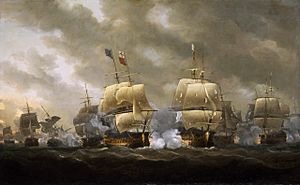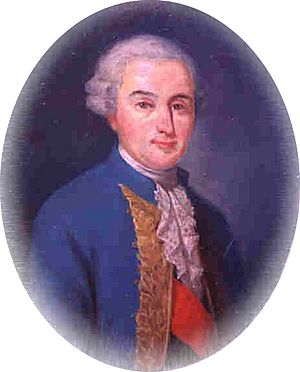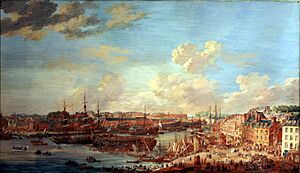Charles Jean d'Hector facts for kids
Charles Jean d'Hector, Count d'Hector (born July 22, 1722, in Fontenay-le-Comte, France – died August 18, 1808, in Reading, Berkshire, United Kingdom) was a French nobleman and a brave naval officer. He joined the French Navy at a young age. He served during the Seven Years' War, where he was part of the important Battle of Quiberon Bay. After this battle, he and another officer, Chevalier de Ternay, helped save part of the French fleet. He was promoted to a high rank, capitaine de vaisseau (ship captain), and later became a squadron commander at the start of the American Revolutionary War. He was put in charge of the important naval port of Brest. There, he worked with the Naval Minister to improve the fleet. He was even visited by important people like the future Tsar Nicholas I and Louis XVI of France. He became a lieutenant general before he had to leave France during the French Revolution. He moved to Britain and, even without much money, he created a volunteer army called the Régiment Hector ou Marine Royale. This group took part in the Quiberon Expedition in 1795. He passed away in England when he was 86 years old.
Contents
His Life Story
Early Years
The Hector family was a noble family from a region in France called Quercy. They were first mentioned in records in 1666. Charles was born a bit sickly and was quickly baptized because people worried he might not survive. His father, who was also a naval officer, died in Canada in 1731. After finishing primary school, Charles moved to Rochefort. He joined the navy as a cadet when he was just 13 years old, on May 16, 1735. He went on several naval trips before becoming a garde-marine (a junior officer) in 1741. He was promoted a few times and then decided to fully join the navy in 1750. He became a lieutenant de vaisseau (lieutenant of the ship) in 1756. In the same year, he was given command of the 30-gun frigate named Pomone.
The Seven Years' War

After chasing Barbary pirates in the Mediterranean Sea, he became an aide-major (a senior assistant) at the port of Brest in 1757. After the big Battle of Quiberon Bay, seven French warships and four frigates found shelter in the Vilaine river estuary. The British admiral, Edward Boscawen, blocked the river entrance. The governor of Brittany asked the Chevalier de Ternay to break this blockade. But de Ternay said he would only do it if Count d'Hector came with him. Together, they managed to outsmart Boscawen and help two ships, the Brillant and the Éveillé, escape. Because of this brave act, Count d'Hector was made a knight of the Order of Saint Louis in 1760. He was also promoted to capitaine de vaisseau (ship captain) in 1762.
In 1772, he married Marie-Jacquette de Kerouartz. Her sisters also married naval officers, showing how connected their families were to the navy.
The American Revolutionary War
In 1778, d'Hector commanded the 74-gun ship Orient. He fought in the Battle of Ushant on July 27, 1778. This battle didn't have a clear winner. Even though he couldn't change the battle's outcome, he was praised for his actions. A few months later, in 1779, he was made chef d'escadre (squadron commander). Then, in December 1779, he was given the most important command at the port of Brest. He played a very important role in Brest's support for the American Revolutionary War.
In 1781, he became the Commandant of the Navy for the Brest region. He helped the Naval Minister, Duc de Castries, with his plans to improve the navy. D'Hector's deep knowledge and experience in battles were very useful. The minister wrote him many letters asking for his advice on managing ports, building ships, and training sailors.
In 1782, d'Hector was promoted to lieutenant general. He also received the red sash of the Order of St. Louis, which came with a pension. These promotions made some of his fellow officers a bit jealous. However, important figures like the future Tsar Paul I and Louis XVI of France supported him. The king even invited d'Hector to meet him at Cherbourg. There, d'Hector shared his ideas about shipbuilding and the need for strong coastal defenses against the British. When the king left Cherbourg, he made d'Hector an inspector of the main naval fortresses. He asked d'Hector to create a plan to unite and coordinate all the commands along the French coast. In 1785, he also helped prepare for the La Perouse Expedition, a famous voyage of exploration.
Life in Exile
When the French Revolution began, d'Hector faced difficulties with the city leaders in Brest. He asked to be relieved of his duties in 1790. He then moved to Koblenz in Germany in 1791. There, he was put in charge of a group called the Corps de la marine royale, which was made up only of naval officers. He didn't have much money, so he asked the Tsar of Russia for help, and the Tsar sent him funds twice. The royalist princes, who supported the king, made him a vice admiral in 1792.
His group was disbanded after a military campaign. But in 1794, it was re-formed in Britain, and d'Hector became its colonel again. He gathered 600 sailors who had fled France and named his group the Régiment Hector. This regiment was sent to Brittany to help with the Quiberon Expedition. However, during their journey, they learned that the expedition had failed. D'Hector was 73 years old by then. He retired to a house near Reading, Berkshire in England. He passed away there on August 18, 1808, at the age of 86.
Images for kids






